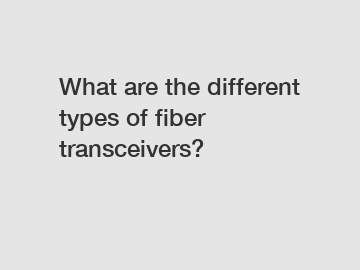What are the different types of fiber transceivers?
Mar. 26, 2024
Have you ever heard of fiber transceivers? If you are unfamiliar with this term, don't worry! I'm here to explain everything you need to know about them. You see, fiber transceivers are devices that transmit and receive data over fiber optic cables. They are commonly used in networking and telecommunications to facilitate high-speed data transmission over long distances. .
Now, let's dive into the different types of fiber transceivers that are available in the market.
1. Single Mode Fiber Transceivers.

Single mode fiber transceivers are designed to work with single mode fiber optic cables. These transceivers use a laser diode as the light source and have a narrower core size compared to multimode fiber transceivers. Single mode fiber transceivers are commonly used in long-distance applications where high bandwidth and low signal loss are crucial.
2. Multimode Fiber Transceivers.
On the other hand, multimode fiber transceivers are designed to work with multimode fiber optic cables. These transceivers use an LED as the light source and have a larger core size compared to single mode fiber transceivers. Multimode fiber transceivers are commonly used in short-distance applications where cost-effectiveness is important.
3. BiDi Fiber Transceivers.
BiDi fiber transceivers, short for bidirectional, use wavelength division multiplexing (WDM) technology to transmit and receive data over a single fiber optic cable. These transceivers are ideal for applications where it is not practical to use two separate fibers for transmitting and receiving data. BiDi fiber transceivers are commonly used in point-to-point and ring topologies.
4. SFP Transceivers.
Small form-factor pluggable (SFP) transceivers are hot-swappable, compact devices that provide flexibility in networking equipment. SFP transceivers come in various types, including single mode, multimode, and BiDi, allowing users to easily upgrade or modify their network setup as needed. These transceivers are commonly used in switches, routers, and media converters.
5. QSFP Transceivers.
Quad small form-factor pluggable (QSFP) transceivers are high-speed, high-density transceivers that support data rates up to 100 Gbps. QSFP transceivers come in different variants, such as QSFP28 for 100 Gbps Ethernet and QSFP+ for 40 Gbps Ethernet. These transceivers are commonly used in data centers and high-performance computing applications.
In conclusion, fiber transceivers come in various types to suit different networking and telecommunications requirements. Whether you need a transceiver for long-distance communication or a cost-effective solution for short-distance applications, there is a fiber transceiver available to meet your needs.
If you are looking for a reliable supplier of fiber transceivers, contact us today to learn more about our products and services. Our team of experts can help you choose the right transceivers for your specific requirements.
If you are looking for more details, kindly visit Fence Sensors, 3G-SDI optical transceiver, RF970 fiber optic fence security system.
21
0
0

Comments
All Comments (0)